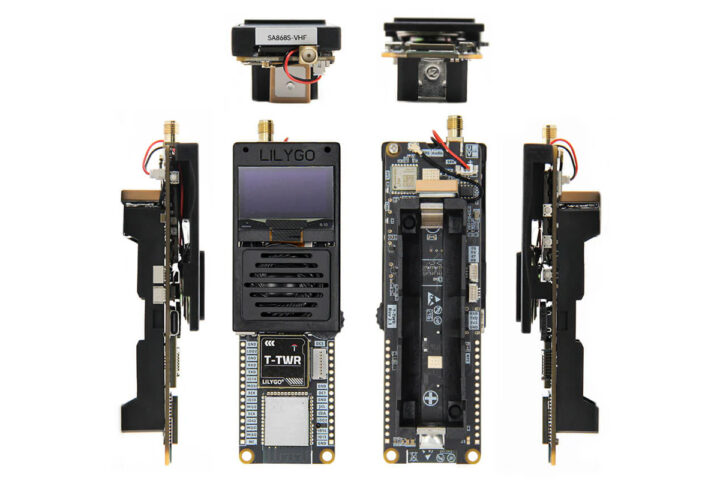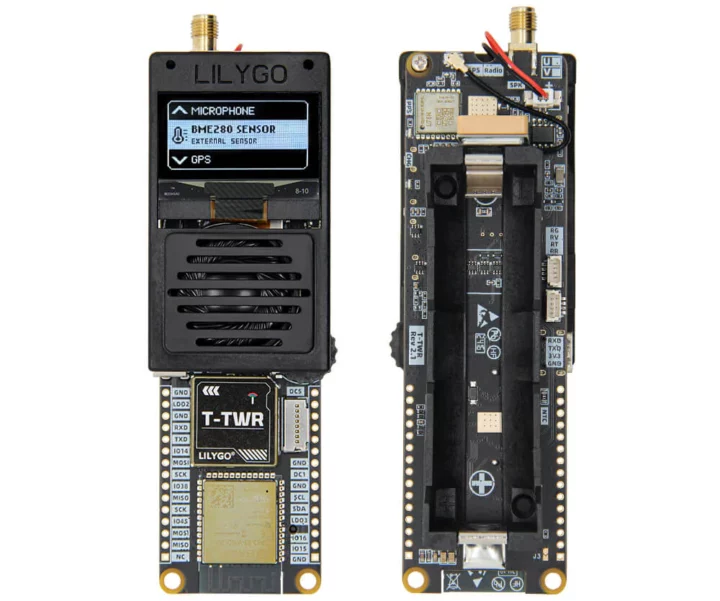LILYGO has recently introduced an updated version of their T-TWR ESP32 walkie-talkie development board, the T-TWR REV2.1. This new board not only features Wi-Fi and Bluetooth but also has a GPS module for added functionality. Additionally, it has a new RF front-end matching circuit that can be configured to work with both VHF and UHF frequencies. The board is very versatile and can be programmed with Arduino IDE for various applications.
The main difference between the older T-TWR and the newer T-TWR REV2.1 is that the new module has better power management with the AXP2102 single-cell Li-battery PWM charger, allowing it to use USB, a 21700 battery, or an 18650 battery, while the original T-TWR only supports USB and an 18650 battery. The new version also includes a GNSS module along with a microphone-switching matrix and a speaker-switching matrix for better sound quality. Additionally, the REV2.1 has the Push-To-Talk button moved to the left side and a more visible status light.
LILYGO T-TWR REV2.1 ESP32 walkie-talkie specification
- Wireless module – Espressif ESP32-S3-WR0OM-1-N16R8 module with ESP32-S3 dual-core LX7 microprocessor @ up to 240 MHz with Vector extension for machine learning, 16MB flash, 8MB PSRAM, WiFi 4 and Bluetooth 5 LE/Mesh
- Display –1.3 inch OLED with 128×64 resolution based on SH1106 I2C display driver
- Networking
- SA868 Walkie-Talkie module based on RDA1846S chip
- Bandwidth: 12.5 kHz/25 kHz
- Sensitivity: -124 dBm
- Support 1.6W or 1.8W mode. The latter is not recommended due to the high temperature when enabled
- Three types:
- UHF @ 400-480 MHz
- VHF @ 134-174 MHz
- “350” @ 320-400 MHz
- SMA antenna connector for UHF/350 antenna or VHF antenna
- L76K GNSS Module
- Multi-GNSS engine for GPS, GLONASS, Galileo, BDS and QZSS
- 99 acquisitions/33 tracking channels and 210 PRN channel
- high sensitivity, -165 dBm @ Tracking, -148 dBm @ Acquisition
- SA868 Walkie-Talkie module based on RDA1846S chip
- Storage – MicroSD card slot
- Audio
- Microphone switching matrix
- Speaker switching matrix
- USB – USB Type-C port for power/charging and programming
- Expansion – 2x 13-pin headers with up to 16x GPIO, 10x ADC, 2x UART, 1x SPI, Touch interface, 5V (VBUS), 3.3V, and GND
- Misc
- Boot, Reset, and user (IO3) button
- Battery switch
- Three-way encoder & switch
- External program header connected to TX and RX
- 1x WS2812C RGB LED
- Power Supply
- 5V via USB port
- 21700 or 18650 battery holder with AXP2101 charging IC.
- Dimensions – 126x 39x 29mm (with SMA connector)
In simple terms, some notable features include the Push-To-Talk button on the left side (similar to a conventional walkie-talkie) and the status light at the top right for better visibility. The RF matching circuit and battery power for the RF module also improve signal quality and reduce noise. In terms of programming the company mentions that the board can be programmed via PlatformIO and Arduino IDE, with examples, documentation, 3D files, images, schematic, and more available on the LILYGO GitHub repository.
The LILYGO T-TWR REV2.1 ESP32 walkie-talkie is available in both VHF and UHF variants. You can find it on Aliexpress, where the VHF module is priced at $58.98 and the UHF module at $57.98. Each kit contains the T-TWR REV2.1 board, along with either a V-band (134-174MHz) or U-band (400-480MHz) antenna depending on the variant, a 4-pin Dupont cable, and additional accessories required for development.
Debashis Das is a technical content writer and embedded engineer with over five years of experience in the industry. With expertise in Embedded C, PCB Design, and SEO optimization, he effectively blends difficult technical topics with clear communication
Support CNX Software! Donate via cryptocurrencies, become a Patron on Patreon, or purchase goods on Amazon or Aliexpress








it looks quite interesting – but why didn’t they designed a full case?
Probably to make sure nobody buys it, and they can blame whatever missing feature that competitors have for its lack of success. As usual.
Probably, they have observed the successful promotion of Meshtastic devices and their popularity due to numerous individuals developing, selling and reviewing cases, such as inkmesh, deskmesh, etc